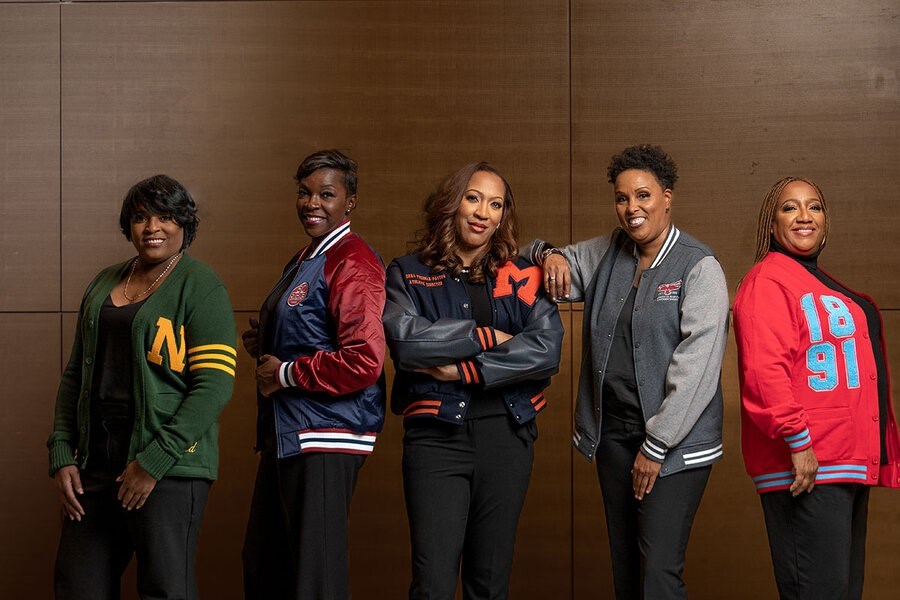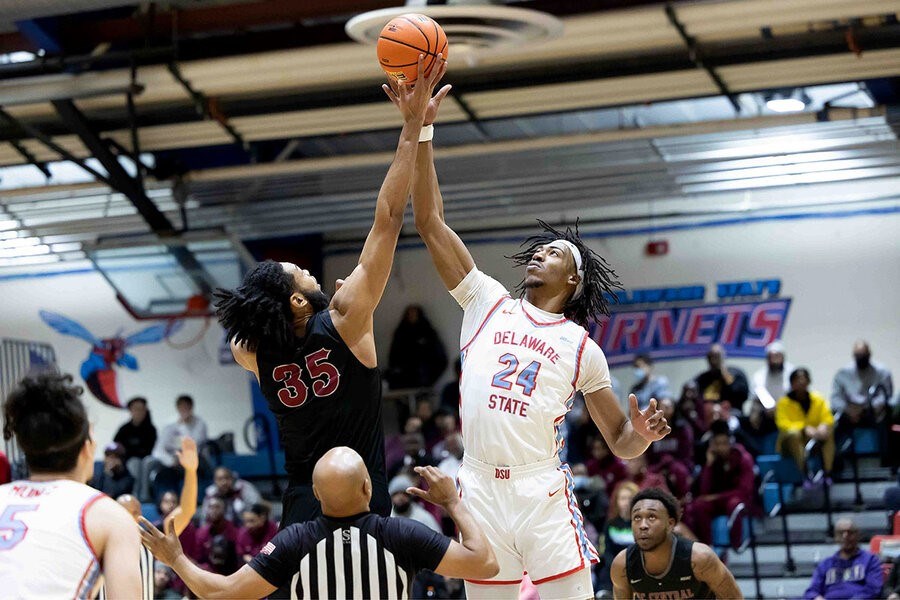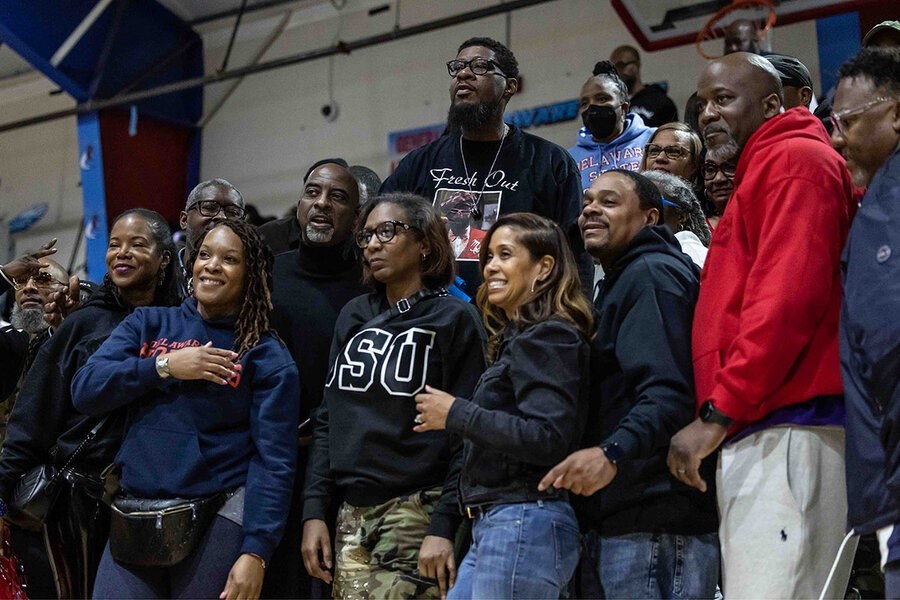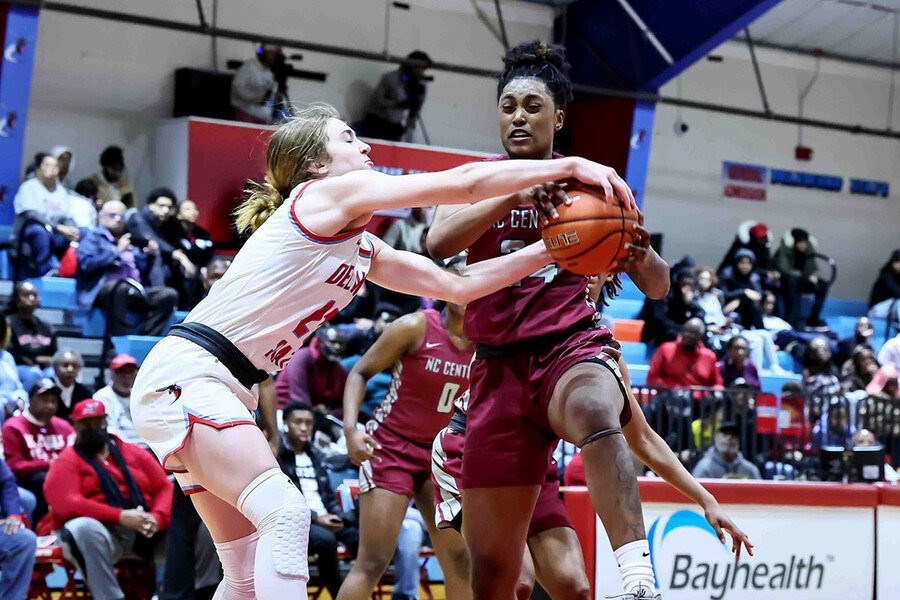REPRINTED WITH PERMISSION FROM THE CHRISTIAN SCIENCE MONITOR
 The "Fab Five" athletic directors oversee sports in five of the eight schools in the Mid-Eastern Athletic Conference. They are (from left to right) Melody Webb from Norfolk State University, Keshia Campbell from South Carolina Sate University, Dena Freeman-Patton from Morgan State University, Tara Owens from the University of Maryland Eastern Shore, and Alecia Shields-Gadson from Delaware State University.Aaron Wilson/MEAC
The "Fab Five" athletic directors oversee sports in five of the eight schools in the Mid-Eastern Athletic Conference. They are (from left to right) Melody Webb from Norfolk State University, Keshia Campbell from South Carolina Sate University, Dena Freeman-Patton from Morgan State University, Tara Owens from the University of Maryland Eastern Shore, and Alecia Shields-Gadson from Delaware State University.Aaron Wilson/MEAC
March 7, 2023
Alumni weekend at Delaware State University is a festival of sights and sounds.
The school is hosting rival North Carolina Central University for a doubleheader between its men’s and women’s basketball teams. Memorial Hall is filled almost to its 1,800 seat capacity, with former students, draped in the customary red and sky blue Hornet colors, band members, majorettes, and cheerleaders. Seasoned alumni with gray hair and canes create a cacophony of cheers and song as the booster club nears its goal of $100,000.
For Alecia Shields-Gadson, however, the pageantry has a bigger point. As athletic director of Delaware State, creating a good time is her job.
“That’s the business that we’re in,” she says. “Athletics is one of those unique pieces on a campus where we’re servicing student athletes because we want to bring them that experience, but we’re serving external constituents, the fan base, and your alumni.”
She points to one tenet of her leadership: Create great customer service. Others might point to another aspect of her leadership: creating a little history.
Ms. Shields-Gadson is one of five female athletic directors in the eight-school Mid-Eastern Athletic Conference (MEAC), which also has a female commissioner. That makes them both – the MEAC and Ms. Sheilds-Gadson – trailblazers. Across Division I college athletics, 15% of athletic directors are female.
The MEAC women have been nicknamed the “Fab Five.” Their path to the top has come through long hours, a conviction in their talent even when they were the only women in the room, and above all a passion for the job. Like many athletic directors, they are former athletes, coaches, and administrators who simply kept climbing. In the MEAC, Ms. Shields-Gadson says, they found bold and progressive presidents who were willing to select them.
 Saquan Stimpson/Special to The Christian Science MonitorDelaware State University Director of Athletics Alecia Shields-Gadson (right) greets Assistant Coach Horace Owens after a game between Delaware State and North Carolina Central University, Feb. 18, 2023, on the campus of Delaware State University in Dover.
Saquan Stimpson/Special to The Christian Science MonitorDelaware State University Director of Athletics Alecia Shields-Gadson (right) greets Assistant Coach Horace Owens after a game between Delaware State and North Carolina Central University, Feb. 18, 2023, on the campus of Delaware State University in Dover.
“I’m not going to call us outliers, because we’re going to be the future, and I think that’s what it shows,” she says. “Our light is shining now, but we have always been here.”
In celebration of the 50th anniversary of Title IX, which bans sexual discrimination in school programming from admissions to athletics, the NCAA released The State of Women in College Sports last year. It found that in the 2019-20 academic year, women made up less than 24% of all athletic director positions. The range was from 15% in Division I schools to 33% in Division III that same year.
The picture at the Power Five schools – the football-driven, big-name programs that generated $2.9 billion in revenue in 2019 – is even starker. Only five of the 65 schools have female athletic directors.
“What’s happening in the MEAC is significant in many ways,” says Marc Christian, a professor of sports industry management at Georgetown University.
For more women and people of color to become athletic directors, decisionmakers must be intentional about equity, he says. This includes more mentoring and specific programming.
“At the end of the day, you want the best people to be in those leadership roles and that’s going to require a diverse population,” says Dr. Christian, who is also the founder of Intellisport Analytics, a research and consulting firm that helps sports leaders make organizational change using research and data. “It’s not always going to come from one segment of the population.”
Some 44% of collegiate athletes are female as of 2019-20, which leads to the question of why leadership does not reflect that number. One idea is for the NCAA to create an equivalent of the Rooney Rule, which dictates that all National Football League teams interview at least one minority candidate when hiring head coaches.
The collegiate West Coast Conference has adopted a so-called “Russell Rule,” named after legendary Celtics player turned coach Bill Russell, which calls for schools to interview underrepresented groups for coaching and senior administrator positions.
 Saquan Stimpson/Special to The Christian Science MonitorNorth Carolina Central center Brendan Medley-Bacon (left) and Delaware State center Raymond Somerville battle for the ball at tip off during a game on Feb. 18, 2023, in Dover, Delaware.
Saquan Stimpson/Special to The Christian Science MonitorNorth Carolina Central center Brendan Medley-Bacon (left) and Delaware State center Raymond Somerville battle for the ball at tip off during a game on Feb. 18, 2023, in Dover, Delaware.
Rising to the top
MEAC Commissioner Sonja Stills has seen the challenges of rising through the ranks from the inside. As the conference’s first female commissioner, she is a trendsetter herself. But she boasts about the MEAC’s women athletic directors more than she does about herself.
“People or universities or companies always say, ‘You know, we want to hire people of color and minorities, but [we] can’t find them,’” Ms. Stills says. “They’re here. They just need the opportunity, and are you really looking?”
She wants women to know they can be commissioners in male-dominated fields, and they don’t need to second-guess themselves.
“Don’t say, ‘Well, I don’t have that, so I’m not going to apply.’ No, a man will check the box of one [requirement] and still apply, and then be given the opportunity to do the job,” she says.
Ms. Stills’ journey speaks to how women can rise to the top. At Hampton University, she was the senior woman administrator – the highest position in collegiate athletics specifically dedicated to women. From there, the learned how to do the behind-the-scenes work needed as for top-level administrators.
She went on to become chief of staff of the MEAC, then its commissioner. She has created the MEAC Nation Association to engage fans, alumni, and potential donors, as well as the nonprofit MEAC Foundation to support member institutions with scholarships for students and grants to pay for salaries, equipment, and facility improvements.
“It’s being able to let the world know, to let little girls and young administrators know, that if you keep pushing that you will be where you want to be,” she says.
 Saquan Stimpson/Special to The Christian Science MonitorDelaware State alumni gather for photos in the stands during the game between Delaware State and North Carolina Central on Feb. 18, 2023.
Saquan Stimpson/Special to The Christian Science MonitorDelaware State alumni gather for photos in the stands during the game between Delaware State and North Carolina Central on Feb. 18, 2023.
Third grade line leader
For Keshia Campbell, the acting athletic director at South Carolina State, the call to leadership came early. It was around election time back in third grade at Blenheim Primary School near her hometown of Bennettsville, South Carolina.
“I think that’s when a lightbulb went off, when I started to think about being a leader,” she says. “But during that time, it was only men that I would see on the news. Largely white males.”
Throughout that year, her teacher drilled it into students that they were leaders, and Ms. Campbell took pride in every task she was given, from being line leader to writing names on the chalkboard.
As a student at South Carolina State, she became captain of the women’s basketball team and is now a member of the school’s athletic hall of fame. Years later, when she was a part of the inaugural class for the NCAA Leadership Institute for Ethnic Minority Females, she remembers telling classmates that she wanted to be an athletic director or college president one day.
“It’s great,” she says of being one of the Fab Five. “I think for us, we just do the work. We don’t keep the data, but it is great and it shows how we are making progress in our country toward opening the doors for more females in top leadership roles in athletic departments.”
As athletic director, she wants to highlight student achievement and make sure the 250 student athletes under her thrive.
 Saquan Stimpson/Special to The Christian Science MonitorDelaware State forward Savannah Brooks (left, in white) defends as North Carolina Central forward Aniya Finger drives to the basket during a game Feb. 18, 2023, in Dover, Delaware.
Saquan Stimpson/Special to The Christian Science MonitorDelaware State forward Savannah Brooks (left, in white) defends as North Carolina Central forward Aniya Finger drives to the basket during a game Feb. 18, 2023, in Dover, Delaware.
A hectic weekend
This can be tireless work.
Ms. Shields-Gadson’s first weekend in February involved a trip to Newark, New Jersey, and then to New York City, for men’s and women’s indoor track competitions and a panel and press briefing for Michael B. Jordan’s Legacy Classic, a basketball showcase featuring schools from Historically Black Colleges and Universities, which was broadcast live on TNT.
“I’ll meet alumni, engage donors, and then from there I’ll hop over to New York to the armory to see the track team. Then, we have track alumni there, so I’ll meet and greet them. Then I’ll drive back home to get ready for church Sunday morning, then I have class, and why not catch bowling, because we have a bowling event in the Wilmington area,” she says ahead of the back-to-back events.
“That’s my whole weekend and then Monday comes and then you just put on the suit and start all over again,” she says with a laugh.
Ms. Shields-Gadson’s road to leadership was long. She was a champion heptathlete at Southern University in Baton Rouge, Louisiana, before becoming a coach and senior woman administrator at Alcorn State University.
When she moved on to Coppin State University in Baltimore, “I went through three engines, two vehicles, and I can’t tell you how many sets of tires” commuting from Wilmington, Delaware.
At times along the way she worked in rooms with mostly, if not all, men. And her ambition came at a cost.
“It wasn’t without sacrifice,” she says. “Personally I went through mom guilt where you sit up and say, ‘I’m with other people’s kids all the time, and I’m missing birthday parties, or I’m missing my daughter’s track meet, because I have to coach.’ ”
She is friends with other members of the Fab Five and has known some of them for decades. Seeing them progress is an indicator of what’s to come, she says.
“We’re just trying to break through the societal expectations. ... There are just as many women that are knowledgeable about athletics,” she says. “I want to see when the world stops when you have a woman as the head football coach.”
“They think we’re going to girlify football and I just chuckle,” she adds. “They think we’re going to start seeing roses on our uniforms. I think that’s the fear, that ‘man cave’ feeling that sports are the final frontier.
“Can this lady handle football?”
Tara Owens, the athletic director at the University of Maryland Eastern Shore, has more than 20 years of experience in athletic administration. But she’s had to fight off similar misperceptions.
“So you walk in the door and the first question is, ‘Can this lady handle football?’” Ms. Owens remembers. “I thought it was staggering. The answer is yes, because this lady is a manager that can handle all sports, no matter the gender, no matter the numbers.”
Men are allowed to come in and operate as if they’re capable and ready to go, no matter what their coaching or administrative experience, she says. But gender had nothing to do with her raising $2.5 million in a previous job, and it will have nothing to do with the millions she plans to raise for Maryland Eastern Shore to upgrade athletic facilities on campus, she adds.
“I sit back and know that I have the years of experience and the tools to sit at the same table,” she says. “I have made it to this table, and I’m going to kick the door down.”
Moreover, women can bring a different perspective. She notes that at the 2021 NCAA basketball tournament, the men had a professional-quality weight room while the women had one small weight rack.
“We should want them to have the same experience as the men,” she says. “We should want them to get to that level of play and feel extremely ecstatic about what they’re doing, and not feel like their counterparts are getting more, because they are doing the same thing.”
Ms. Owens loves seeing women in the driver seat, whether in Power Five schools or Division III, because she knows the doubts and trials they endured to get there. And she believes they will get results.
“I think that we bring a different level of thought and experience to this position, and I think it’s very much needed,” she says.
Everyone wins
It isn’t just women who are celebrating the accomplishments of the Fab Five, who also include Dena Freeman-Patton of Morgan State University and Melody Webb of Norfolk State University.
Derek Carter is the athletic director at Coppin State University, a fellow MEAC school. He has known, worked with, or competed against many of the women for years. And he applauds what they have accomplished. He believes it has the potential to create a pipeline for other women to follow.
“It’s great for them as role models, the examples they provide for young women to see that this business of athletics does not have to be male dominated,” he says. “We have just as many female athletes as we do male athletes for the most part, so leadership should be the same way.”
He gets occasional jokes about male athletic directors in the MEAC being in the minority. But he brushes them off. He knows how hard his female counterparts had to work to get where they are.
“Those jobs are hard to come by,” Mr. Carter says. “When a position opens up, you will not believe the number of people of all races and genders trying to get those positions.”
With the success of the Fab Five, more conferences should follow suit, he adds. People have changed their way of thinking.
“We have males that have been in leadership and decision-making positions hiring those that are like them,” he says. “And this argument can be transferred to race, gender, whatever. So I’m happy that progress was made, and usually when progress begins it will just get more momentum.”
Editor’s note: This article has been updated to add Marc Christian’s attribution to one paragraph.
Related stories
Page created on 3/14/2023 8:10:57 PM
Last edited 3/14/2023 8:40:48 PM
